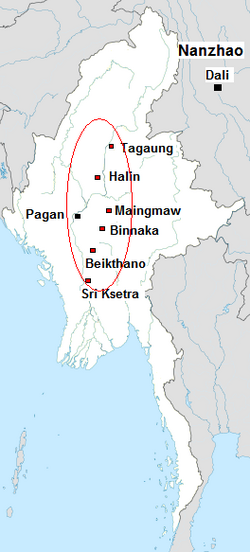Kingdom of Tagaung
| Kingdom of Tagaung | ||||||||
| တကောင်း နေပြည်တော် | ||||||||
|
||||||||
| Capital | Tagaung | |||||||
| Languages | Pyu, Burmese | |||||||
| Religion | Buddhism, animism, Brahmanism | |||||||
| Government | Monarchy | |||||||
| Historical era | Classical Antiquity | |||||||
| • | Founding of Kingdom | c. 1st century CE | ||||||
| • | Fall of Kingdom | c. 1050s | ||||||
|
||||||||
Tagaung Kingdom (Burmese: တကောင်း နေပြည်တော်, pronounced [dəɡáʊɴ nèpjìdɔ̀]) was a Pyu city-state that existed in the first millennium CE. In 1832, the hitherto semi-legendary state was officially proclaimed the first kingdom of Burmese monarchy by Hmannan Yazawin, the Royal Chronicle of the Konbaung Dynasty. Hmannan adds that the "kingdom" was founded by Abhiyaza of the Sakya clan of the Buddha in 850 BCE, and that through Abiyaza, Burmese monarchs traced their lineage to the Buddha and the first Buddhist (mythical) king of the world Maha Sammata.Hmannan also introduces another Sakya prince Dazayaza who founded the second Tagaung dynasty c. 600 BCE. The narrative superseded then prevailing pre-Buddhist origin story in which the monarchy was founded by a descendant of a solar spirit and a dragon princess.
Archaeological evidence indicates that Neolithic and Bronze Age cultures existed at Tagaung, and a city-state founded by the Pyu emerged in the early centuries CE. The chronicles, which likely represent the social memory of the times, repeatedly mention multiple competing groups and migrations that Tagaung and the entire Pyu realm experienced in the first millennium CE. The city-state became part of the Pagan Empire in the mid-1050s.
...
Wikipedia

